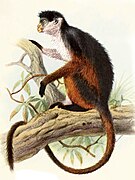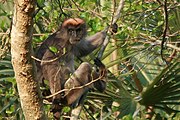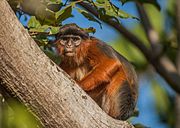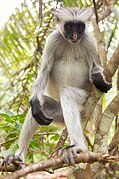Superregnum: Eukaryota
Cladus: Unikonta
Cladus: Opisthokonta
Cladus: Holozoa
Regnum: Animalia
Subregnum: Eumetazoa
Cladus: Bilateria
Cladus: Nephrozoa
Superphylum: Deuterostomia
Phylum: Chordata
Subphylum: Vertebrata
Infraphylum: Gnathostomata
Megaclassis: Osteichthyes
Cladus: Sarcopterygii
Cladus: Rhipidistia
Cladus: Tetrapodomorpha
Cladus: Eotetrapodiformes
Cladus: Elpistostegalia
Superclassis: Tetrapoda
Cladus: Reptiliomorpha
Cladus: Amniota
Cladus: Synapsida
Cladus: Eupelycosauria
Cladus: Sphenacodontia
Cladus: Sphenacodontoidea
Cladus: Therapsida
Cladus: Theriodontia
Cladus: Cynodontia
Cladus: Eucynodontia
Cladus: Probainognathia
Cladus: Prozostrodontia
Cladus: Mammaliaformes
Classis: Mammalia
Subclassis: Trechnotheria
Infraclassis: Zatheria
Supercohors: Theria
Cohors: Eutheria
Infraclassis: Placentalia
Cladus: Boreoeutheria
Superordo: Euarchontoglires
Ordo: Primates
Subordo: Haplorhini
Infraordo: Simiiformes
Parvordo: Catarrhini
Superfamilia: Cercopithecoidea
Familia: Cercopithecidae
Subfamilia: Colobinae
Tribus: Colobini
Genus: Piliocolobus
Species: P. badius – P. bouvieri – P. epieni – P. foai – P. gordonorum – P. kirkii – P. langi – P. oustaleti – P. parmentieri – P. pennantii – P. preussi – P. rufomitratus – P. semlikiensis – P. tephrosceles – P. tholloni – P. waldroni
Name
Piliocolobus Rochebrune, 1887
Type species: Simia (Cercopithecus) badius Kerr, 1792
Synonymy
Piliocolobus Rochebrune, 1887: 96
Tropicolobus Rochebrune, 1887: 96
References
Primary references
de Rochebrune, A.T. 1886–1887. Faune de la Sénégambie. Supplément aux vertébrés. I. Mammifères. Paris: Octave Doin. BHL Reference page.
Links
Piliocolobus in Mammal Species of the World.
Wilson, Don E. & Reeder, DeeAnn M. (Editors) 2005. Mammal Species of the World – A Taxonomic and Geographic Reference. Third edition. ISBN 0-8018-8221-4.
Vernacular names
English: Red Colobus
日本語: アカコロブス属
Red colobuses are Old World monkeys of the genus Piliocolobus.[4] It was formerly considered a subgenus within the genus Procolobus, which is now restricted to the olive colobus.[1] They are closely related to the black-and-white colobus monkeys (genus Colobus), and some species are often found in groups with the blue monkey.[5] The western red colobus is frequently hunted by the common chimpanzee.[6]
The members of this genus are found in western, central and eastern Africa, and the species have largely allo- or parapatric distributions. They are primarily arboreal and most are restricted to humid forests, but the Zanzibar red colobus prefers coastal thickets and scrub. Red colobuses are highly sensitive to hunting and habitat destruction, and have been referred to as probably the most threatened taxonomic group of primates in Africa.[7] If following the taxonomic treatment advocated in Mammal Species of the World,[1] all species except the Udzungwa, Semliki, Oustalet's and Thollon's red colobus monkeys (which are vulnerable) are assessed by the IUCN as endangered or critically endangered.[8] Due to this sensitivity, it has been argued that they are indicator species for the health of Africa's tropical forests, leading researchers to urge that they be conserved as umbrella species.[9]
Social behavior
Groups often establish a dominance hierarchy determined by aggressive behavior. Food, grooming, and sexual partners are distributed amongst higher-ranking individuals initially, followed by lower-ranking individuals.[10] They live in large troops which can number up to 80 individuals, the average being somewhere around 20 to 40 monkeys. These groups tend to have more females than males at a 2:1 ratio. The few male monkeys in the troop usually stay with their original group, but the females have a tendency to move together in small numbers, probably in close familial relationships, between troops. Red colobus monkeys have overlapping ranges with other troops. Interactions between troops can be either tense, though passive, or violent, with one troop trying to supplant the other. These fights are usually based on a number of factors including physical condition, fighting ability, and the number of males in the opposing troop. Females are also known to take part in these competitions for dominance, and often fight together. Mother-infant bonds among the red colobus are quite strong, as they are with most primates. The mothers are usually reluctant to allow other females from their troop to carry their babies. This may be because many of the females in a troop are not related as they move between groups quite frequently.[11]
Another remarkable behavior occurs when red colobus monkeys reach their restless and somewhat nomadic adolescence. This period is when the young monkeys leave their natal troops and look for another troop to join. This is not easy, as most troops are very suspicious and can get deadly when new monkeys try to join. The red colobus monkeys have adapted their behavior by joining troops of green monkeys that are near the potential red colobus troops that they wish to join, and living amongst them in order to spy on their potential new families. In one notable case, an adolescent male red colobus spent two years with a green monkey troop in order to spy in safety on a prospective troop in this manner.[12]
Diet
The diet of red colobus monkeys consists mainly of young leaves, flowers, and unripe fruit.[13] They are also known to eat charcoal or clay to help combat the cyanide some leaves may contain. This medicinal cure for the plants they eat appears to be passed on from mother to child.[14] However, their stomachs are able to digest some toxic plants that other primates cannot.[13] Red colobus monkeys are extraordinarily adapted to their entirely vegetarian and widely varied diet. They have special salivary glands, which are larger and produce more specialized saliva to help facilitate the breakdown of leaves before they reach the digestive tract. The stomach of the red colobus is also sacculated into four chambers (similar to unrelated ungulates) and larger than those of other monkeys of a comparative size. This allows for longer digestion, so that most of the nutrients can be gleaned from the relatively low nutrient food.[15]
Chimpanzee predation
Research indicates that chimpanzee predation may be a major selection factor on some red colobus populations.[16] Although chimpanzees primarily eat fruit, leaves, and insects, if the opportunity to eat meat arises, they will pursue it. In addition to sustenance, evidence suggests that chimpanzees prey on red colobus to reinforce social status, as well as to attract sexual partners.[17] When under attack, the red colobus males congregate to defend their group, while the females gather their infants and try to escape. Larger groups of red colobuses have an increased likelihood of attracting chimpanzees, but they also tend to have more defending males, making it harder for chimpanzees to hunt successfully.[18] Furthermore, while under attack, male colobuses shout an alarm call to let others know if chimpanzees or other predators are in the area. The frequency of these shouts is increased with the number of females and infants in the group as a way to spread the news of an expected attack.[19] At Gombe National Park in Tanzania C.B. Stanford estimated that the Gombe chimps kill up to 100 colobus monkeys a year, which he believes to be close to a fifth of the colobus population within their territory.[20] Another study confirms that chimpanzees are annually responsible for 6-12 percent of red colobus female and infant death in Ngogo, Kibale National Park, which has one of the largest populations of chimpanzees. It seems that chimpanzees tend to favor the red colobus as prey whenever the two are in the same territory, hunting in groups of up to 20 individual chimps. During these hunts in Tai, Gombe, Ngogo, and Mahale National Parks, ≥ 87 percent of the hunts made more than one kill. The highest amount of kills seen during this study was 13, most of which were infants.[21]
Species
| Common name | Scientific name and subspecies | Range | Size and ecology | IUCN status and estimated population |
|---|---|---|---|---|
| Bouvier's red colobus
|
P. bouvieri Rochebrune, 1887 |
Congo (in purple on left) |
Size: 41–70 cm (16–28 in) long, plus 42–80 cm (17–31 in) tail[22] Habitat: Forest[23] Diet: Fruit, seeds, and leaves[22] |
EN
|
| Foa's red colobus
|
P. foai (Pousargues, 1899) |
Congo (in black, bottom right) |
Size: 41–70 cm (16–28 in) long, plus 42–80 cm (17–31 in) tail[22] Habitat: Forest[24] Diet: Fruit, seeds, and leaves[22] |
EN
|
| Lang's red colobus
|
P. langi (J. A. Allen, 1925) |
Congo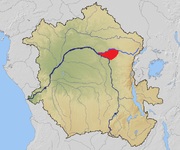 |
Size: 41–70 cm (16–28 in) long, plus 42–80 cm (17–31 in) tail[22] Habitat: Forest[25] Diet: Fruit, seeds, and leaves[22] |
EN
|
| Lomami red colobus
|
P. parmentieri (Colyn & Verheyen, 1987) |
Congo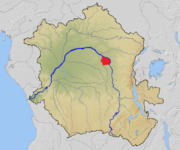 |
Size: 41–70 cm (16–28 in) long, plus 42–80 cm (17–31 in) tail[22] Habitat: Forest[26] Diet: Fruit, seeds, and leaves[22] |
EN
|
| Miss Waldron's red colobus
|
P. waldronae (Hayman, 1936) |
Western Africa |
Size: 47–63 cm (19–25 in) long, plus 52–75 cm (20–30 in) tail[27] Habitat: Forest[28] Diet: Fruit, seeds, leaves, buds, and flowers[27] |
CR
|
| Niger Delta red colobus
|
P. epieni (Grubb & Powell, 1999) |
Western Africa | Size: 41–70 cm (16–28 in) long, plus 42–80 cm (17–31 in) tail[22] Habitat: Forest[29] Diet: Fruit, seeds, and leaves[22] |
CR
|
| Oustalet's red colobus
|
P. oustaleti (Trouessart, 1906) |
Congo (in green) |
Size: 41–70 cm (16–28 in) long, plus 42–80 cm (17–31 in) tail[22] Habitat: Forest[30] Diet: Fruit, seeds, and leaves[22] |
VU
|
| Pennant's colobus
|
P. pennantii (Waterhouse, 1838) |
Western Africa |
Size: 53–63 cm (21–25 in) long, plus 60–70 cm (24–28 in) tail[31] Habitat: Forest[32] Diet: Leaves and shoots, as well as seeds and fruit[31] |
CR
|
| Preuss's red colobus
|
P. preussi Matschie, 1900 |
Western Africa |
Size: 41–70 cm (16–28 in) long, plus 42–80 cm (17–31 in) tail[22] Habitat: Forest[33] Diet: Fruit, seeds, and leaves[22] |
CR
|
| Semliki red colobus
|
P. semlikiensis (Colyn, 1991) |
Congo (in dark blue on right) |
Size: 41–70 cm (16–28 in) long, plus 42–80 cm (17–31 in) tail[22] Habitat: Forest[34] Diet: Fruit, seeds, and leaves[22] |
VU
|
| Tana River red colobus
|
P. rufomitratus (Peters, 1879) |
Kenya | Size: 45–67 cm (18–26 in) long, plus 52–80 cm (20–31 in) tail[35] Habitat: Forest, shrubland, and inland wetlands[36] Diet: Leaves, fruit, and seeds, as well as flowers[35] |
CR
|
| Thollon's red colobus
|
P. tholloni (A. Milne-Edwards, 1886) |
Congo (in orange) |
Size: 41–70 cm (16–28 in) long, plus 42–80 cm (17–31 in) tail[22] Habitat: Forest[37] Diet: Leaves, fruit, and seeds, as well as flowers[37] |
VU
|
| Udzungwa red colobus
|
P. gordonorum Matschie, 1900 |
Southeastern Africa |
Size: 41–70 cm (16–28 in) long, plus 42–80 cm (17–31 in) tail[22] Habitat: Forest[38] Diet: Fruit, seeds, and leaves[22] |
VU
|
| Ugandan red colobus
|
P. tephrosceles (Elliot, 1907) |
Eastern Africa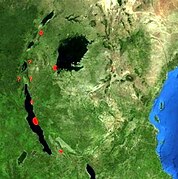 |
Size: 41–70 cm (16–28 in) long, plus 42–80 cm (17–31 in) tail[22] Habitat: Forest and savanna[39] Diet: Fruit, seeds, and leaves[22] |
EN
|
| Western red colobus
|
P. badius (Kerr, 1792)
Three subspecies
|
Western Africa |
Size: 45–67 cm (18–26 in) long, plus 52–80 cm (20–31 in) tail Habitat: Forest and savanna[40] Diet: Leaves, seeds, unripe fruit, and shoots[41] |
EN
|
| Zanzibar red colobus
|
P. kirkii (Gray, 1868) |
Eastern Africa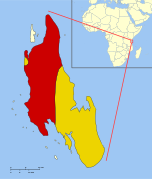 |
Size: 41–70 cm (16–28 in) long, plus 42–80 cm (17–31 in) tail[22] Habitat: Forest and shrubland[42] Diet: Leaves, fruit, and seeds, as well as flowers[43] |
EN
|
|---|
Colin Groves did not recognize all these species in the 2005 Mammal Species of the World, but he subsequently agreed that additional species should be recognized.[1][44] These species are generally agreed upon although different authors may use slightly different taxonomies. For example, the Integrated Taxonomic Information System, IUCN Red List, and Mammal Diversity Database list Temminck's red colobus as a subspecies of the Western red colobus, Piliocolobus badius temminckii,[45][46][47][48] but The Handbook of Mammals of the World regarded it as a full species.[4] In addition to the recognized species, there is also a hybrid zone in the eastern Democratic Republic of Congo where hybrids of several local species exist.[45]
References
Groves, C. P. (2005). "GENUS Piliocolobus". In Wilson, D. E.; Reeder, D. M. (eds.). Mammal Species of the World: A Taxonomic and Geographic Reference (3rd ed.). Baltimore: Johns Hopkins University Press. pp. 169–170. ISBN 0-801-88221-4. OCLC 62265494.
Groves, Colin (2007). "The taxonomic diversity of the Colobinae of Africa" (PDF). Journal of Anthropological Sciences. 85: 16.
de Rochebrune, A. (1887). Faune de Senegambie (Supplement). p. 96.
Zinner, D.; Fickenscher, G.H.; Roos, C. (2013). Mittermeier, Russell A.; Rylands, Anthony B.; Wilson, Don E. (eds.). Handbook of the Mammals of the World: Volume 3, Primates. Lynx. pp. 705–712. ISBN 978-8496553897.
Ghiglieri, Michael. East of the Mountains of the Moon: Chimpanzee Society in the African Rain Forest, The Free Press, 1988, pg. 238.
Ebola Cote d'Ivoire Outbreaks
Mittermeier, R. A., Ratsimbazafy, J., Rylands, A. B., Williamson, L., Oates, J. F., Mbora, D., Ganzhorn, J. U., Rodríguez-Luna, E., Palacios, E., Heymann, E. W., Kierulff, M. C. M., Yongcheng, L., Supriatna, J., Roos, C., Walker, S., & Aguiar, J. M. (2007). Primates in Peril: The World's 25 Most Endangered Primates, 2006–2008. Primate Conservation 2007 (22): 1-40
IUCN 2008. 2008 IUCN Red List of Threatened Species. Downloaded on 12 September 2011.
Linder, Joshua M.; Cronin, Drew T.; Ting, Nelson; Abwe, Ekwoge E.; Aghomo, Florence; Davenport, Tim R. B.; Detwiler, Kate M.; Galat, Gérard; Galat-Luong, Anh; Hart, John A.; Ikemeh, Rachel A.; Kivai, Stanislaus M.; Koné, Inza; Konstant, William; Kujirakwinja, Deo (2024-04-30). "To conserve African tropical forests, invest in the protection of its most endangered group of monkeys, red colobus". Conservation Letters. 17 (3). Bibcode:2024ConL...17E3014L. doi:10.1111/conl.13014. ISSN 1755-263X.
Mbora, D. N. M., & Meikle, D. B. (2004). Forest fragmentation and the distribution, abundance and conservation of the tana river red colobus (procolobus rufomitratus). Biological Conservation, 118(1), 67-77.
Oates, J (1994). Colobine monkeys: their ecology, behavior, and evolution. Cambridge: The Syndicate Press of the University of Cambridge. pp. 107–118.
Starin, E.D. (1993). "The kindness of strangers". Natural History. 102 (10): 44.
Foraging challenges of red colobus monkeys: influence of nutrients and secondary compounds Original Research Article Comparative Biochemistry and Physiology - Part A: Molecular & Integrative Physiology, Volume 133, Issue 3, November 2002, Pages 861-875 Colin A. Chapman, Lauren J. Chapman
Bruemmer, F (2010). "A charcoal a day". Natural History. 119 (2): 2–4.
Swindler, D. (1998). Introduction to the primates. Seattle: University of Washington Press. p. 47. ISBN 9780295977041.
Stanford, C. B. (1995). The influence of chimpanzee predation on group size and anti-predator behaviour in red colobus monkeys. Animal Behaviour, 49(3), 577-587.
Chimpanzee and Red Colobus: The Ecology of Predator and Prey: By Craig B. Stanford, Harvard University Press, 1999, 296 pp; ISBN 0-674-11667-4 Physiology & Behavior, Volume 76, Issue 1, 1 May 2002, Pages 171-172 David P. Barash
Mbora, D. N. M., & Meikle, D. B. (2004). Forest fragmentation and the distribution, abundance and conservation of the tana river red colobus (Procolobus rufomitratus). Biological Conservation, 118(1), 67-77.
Schel, A. M., Candiotti, A., & Zuberbühler, K. (2010). Predator-deterring alarm call sequences in guereza colobus monkeys are meaningful to conspecifics. Animal Behaviour, 80(5), 799-808.
Stanford, C., (1995). To catch a colobus. Natural History, 104(1) 48
Watts, D. P., & Mitani, J. C., (2002). Hunting behavior of chimpanzees at Ngogo, Kibale National Park, Uganda. International Journal of Primatology, 23(1) 1-28
Kingdon 2015, p. 103
Maisels, F.; Devreese, L. (2022) [amended version of 2020 assessment]. "Piliocolobus bouvieri". IUCN Red List of Threatened Species. 2022: e.T18250A210339606. doi:10.2305/IUCN.UK.2022-1.RLTS.T18250A210339606.en.
Hart, J.; Ting, N.; Maisels, F. (2020). "Piliocolobus foai". IUCN Red List of Threatened Species. 2020: e.T18252A92659769. doi:10.2305/IUCN.UK.2020-1.RLTS.T18252A92659769.en.
Hart, J.; Laudisoit, A.; Struhsaker, T. T.; Oates, J. F. (2020) [amended version of 2019 assessment]. "Piliocolobus langi". IUCN Red List of Threatened Species. 2020: e.T18261A166605018. doi:10.2305/IUCN.UK.2020-1.RLTS.T18261A166605018.en.
Hart, J. A.; Detwiler, K. M. (2020) [amended version of 2019 assessment]. "Piliocolobus parmentieri". IUCN Red List of Threatened Species. 2020: e.T40648A166604269. doi:10.2305/IUCN.UK.2020-1.RLTS.T40648A166604269.en.
Kingdon 2015, p. 110
Oates, J. F.; Koné, I.; McGraw, S.; Osei, D. (2020) [amended version of 2019 assessment]. "Piliocolobus waldroni". IUCN Red List of Threatened Species. 2020: e.T18248A166620835. doi:10.2305/IUCN.UK.2020-1.RLTS.T18248A166620835.en.
Ikemeh, R.; Oates, J. F.; Inaoyom, I. (2019). "Piliocolobus epieni". IUCN Red List of Threatened Species. 2019: e.T41024A92656391. doi:10.2305/IUCN.UK.2019-3.RLTS.T41024A92656391.en.
Hart, J.; Maisels, F.; Oates, J. F.; Laudisoit, A.; Hicks, T. C.; Struhsaker, T. T. (2020) [amended version of 2019 assessment]. "Piliocolobus oustaleti". IUCN Red List of Threatened Species. 2020: e.T18255A166598553. doi:10.2305/IUCN.UK.2020-1.RLTS.T18255A166598553.en.
Gilbert, Kasi (2011). "Piliocolobus pennantii". Animal Diversity Web. University of Michigan. Archived from the original on July 24, 2023. Retrieved July 24, 2023.
Cronin, D. T. (2019). "Piliocolobus pennantii". IUCN Red List of Threatened Species. 2019: e.T41025A92653653. doi:10.2305/IUCN.UK.2019-3.RLTS.T41025A92653653.en.
Linder, J.; Morgan, B. J.; Abwe, E. E.; Jost Robinson, C. A.; Imong, I.; Oates, J. F. (2019). "Piliocolobus preussi". IUCN Red List of Threatened Species. 2019: e.T41026A92633245. doi:10.2305/IUCN.UK.2019-3.RLTS.T41026A92633245.en.
Maisels, F.; Ting, N. (2020). "Piliocolobus semlikiensis". IUCN Red List of Threatened Species. 2020: e.T92657343A92657454. doi:10.2305/IUCN.UK.2020-1.RLTS.T92657343A92657454.en.
Jones, Jeremy (2002). "Piliocolobus rufomitratus". Animal Diversity Web. University of Michigan. Archived from the original on August 12, 2023. Retrieved July 24, 2023.
Butynski, T. M.; de Jong, Y. A.; King, J. (2020) [amended version of 2019 assessment]. "Piliocolobus rufomitratus". IUCN Red List of Threatened Species. 2020: e.T136939A166599765. doi:10.2305/IUCN.UK.2020-1.RLTS.T136939A166599765.en.
Detwiler, K. M.; Hart, J. A.; Maisels, F.; Thompson, J.; Reinartz, G.; Struhsaker, T. T. (2020) [amended version of 2019 assessment]. "Piliocolobus tholloni". IUCN Red List of Threatened Species. 2020: e.T18257A166598109. doi:10.2305/IUCN.UK.2020-1.RLTS.T18257A166598109.en.
Rovero, F.; Barelli, C; Butynski, T. M.; Marshall, A. J.; Struhsaker, T. T. (2019). "Piliocolobus gordonorum". IUCN Red List of Threatened Species. 2019: e.T40015A92629595. doi:10.2305/IUCN.UK.2019-3.RLTS.T40015A92629595.en.
Struhsaker, T. T.; Ting, N. (2020) [errata version of 2020 assessment]. "Piliocolobus tephrosceles". IUCN Red List of Threatened Species. 2020: e.T18256A171760021. doi:10.2305/IUCN.UK.2020-1.RLTS.T18256A171760021.en.
McGraw, S.; Minhós, T.; Bersacola, E.; Ferreira da Silva, M. J.; Galat, G.; Galat-Luong, A.; Gonedelé Bi, S.; Mayhew, M.; Oates, J. F.; Starin, E. D. (2020). "Piliocolobus badius". IUCN Red List of Threatened Species. 2020: e.T161247840A161259430. doi:10.2305/IUCN.UK.2020-1.RLTS.T161247840A161259430.en.
Vasselin, Kathleen (2011). "Piliocolobus badius". Animal Diversity Web. University of Michigan. Archived from the original on August 12, 2023. Retrieved July 24, 2023.
Davenport, T. (2020) [errata version of 2019 assessment]. "Piliocolobus kirkii". IUCN Red List of Threatened Species. 2019: e.T39992A168568335. doi:10.2305/IUCN.UK.2019-3.RLTS.T39992A168568335.en.
Smit, Josephine (2012). "Piliocolobus kirkii". Animal Diversity Web. University of Michigan. Archived from the original on August 12, 2023. Retrieved July 24, 2023.
Groves, C.P. (2016). "Species concepts and conservation". In Wich, Serge A.; Marshall, Andrew J. (eds.). An Introduction to Primate Conservation. Oxford University Press. pp. 45–47. ISBN 9780198703396.
Oates, John & Ting, Nelson (2015). "Conservation consequences of unstable taxonomies: The case of the red colobus monkeys" (PDF). Molecular Anthropology Group at the University of Oregon. Retrieved 2019-01-23.
"Piliocolobus badius temminckii". ITIS. Retrieved 2019-01-23.
Minhós, T. (2020). "Piliocolobus badius ssp. temminckii". IUCN Red List of Threatened Species. 2020: e.T18247A92648587. doi:10.2305/IUCN.UK.2020-1.RLTS.T18247A92648587.en. Retrieved 29 January 2022.
"Piliocolobus badius (Kerr, 1792)". Mammal Diversity Database. American Society of Mammalogists. Retrieved 29 January 2022.
Sources
Kingdon, Jonathan (2015). The Kingdon Field Guide to African Mammals (Second ed.). Bloomsbury Publishing. ISBN 978-1-4729-2531-2.
Retrieved from "http://en.wikipedia.org/"
All text is available under the terms of the GNU Free Documentation License

